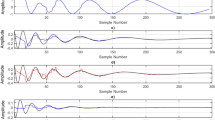Abstract
The fast Fourier transform (FFT) and, recently, the fast Hartley transform (FHT) have been extensively used by geodesists for efficient geoid determination. For this kind of efficiency, data must be given on a regular grid and, consequently, a pre-processing step of interpolation is required when only point measurements are available. This paper presents a way of computing a grid of geoid undulations N without explicitly gridding the data. The method is applicable to all FFT or FHT techniques of geoid or terrain effects determination, and it works with planar as well as spherical formulas. This method can be used not only for, e.g., computing a grid of undulations from irregular gravity anomalies Δg but it also lends itself to other applications, such as the gridding of gravity anomalies and, since the contribution of each data point is computed individually, the update of N- or Δg-grids as soon as new point measurements become available. In the case that there are grid cells which contain no measurements, the results of gravity interpolation or geoid estimation can be drastically improved by incorporating into the procedure a frequency-domain interpolating function. In addition to numerical results obtained using a few simple interpolating functions, the paper presents briefly the mathematical formulas for recovering missing grid values and for transforming values from one grid to another which might be rotated and/or scaled with respect to the first one. The geodetic problems where these techniques may find applications are pointed out throughout the paper.
Similar content being viewed by others
References
Blais, J.A.R., 1982, A Synthesis of Kriging Estimation Methods,Manuscripta Geodaetica Vol. 7, pp. 325–352.
Bracewell, R.N., 1986a,The Fast Hartley Transform, Oxford Engineering Science Series No. 19, Oxford University Press.
Bracewell, R.N., 1986b,The Fourier Transform and its Applications, Second edition, revised. McGraw-Hill, New-York.
Cressie, N., 1992,Spatial Data Analysis, John Wiley & Sons, Inc., New York.
Dudgeon, D.E. and Mersereau, R.M., 1984,Multidimensional Digital Signal Processing, Prentice-Hall, Inc., Englewood Cliffs, New Jersey.
Eren, K., 1980, Spectral Analysis of GEOS-3 Altimeter Data and Frequency Domain Collocation, OSU Report No. 297, The Ohio State University, Department of Geodetic Science, Columbus, Ohio.
Haagmans, R., de Min, E. and van Gelderen, M., 1993, Fast Evaluation of Convolution Integrals on the Sphere Using 1D FFT, and a Comparison With Existing Methods for Stokes' Integral,Manuscripta Geodaetica Vol. 18, pp. 227–241.
Lancaster, P. and Salkauskas, K., 1986,Curve and Surface Fitting — An Introduction, Academic Press, Inc., London.
Li, Y.C. and Sideris, M.G. 1992, The Fast Hartley Transform and Its Application in Physical Geodesy,Manuscripta Geodaetica Vol. 17, pp. 281–387.
Li. Y.C., 1993, Optimized Spectral Geoid Determination, UCGE Report No. 20050, The University of Calgary, Department of Geomatics Engineering, Calgary, Alberta.
Marks II, R.J., 1991,Introduction to Shannon Sampling and Interpolation Theory, Springer-Verlag, New York.
Meskó, A., 1984,Digital Filtering: Applications in Geophysical Exploration for Oil. Akadémiai Kiadó, Budapest.
Oppenheim, A.V. and Schafer, R.W., 1989,Discrete-Time Signal Processing, Prentice Hall, Englewood Cliffs, N.J. 07632.
Schafer, R.W. and Rabiner, L.R., 1973, A Digital Signal Processing Approach to Interpolation,Proceedings of the IEEE Vol. 61, No. 6, pp. 692–702.
Schwarz, K.P., Sideris, M.G. and Forsberg, R., 1990, The Use of FFT techniques in physical geodesy,Geophysical Journal International Vol. 100, pp. 485–514.
Sideris, M.G. and Li, Y.C., 1993, Gravity Field Convolutions Without Windowing and Edge Effects,Bulletin Géodésique Vol. 67, pp. 107–118.
Sideris, M.G. and Tziavos, I.N., 1988, FFT-Evaluation and Applications of Gravity-Field Convolution Integrals With Mean and Point Data,Bulletin Géodésique Vol. 62, pp. 521–540.
Soumekh, M., 1988, Band-Limited Interpolation From Unevenly Spaced Sampled Data,IEEE Transactions on Acoustics, Speech, and Signal Processing Vol. 36, No. 1, pp. 110–121.
Sünkel, H., 1981, Cardinal Interpolation, OSU Report No. 312, The Ohio State University, Department of Geodetic Science, Columbus, Ohio.
Tziavos, I.N., 1993, Numerical Considerations of FFT Methods in Gravity Field Modelling, Wissenschaftliche Arbeiten der Fachrichtung Vermessungswesen der Universität Hannover Nr. 188, Hannover.
Vermeer, M., 1992, A Frequency Domain Approach to Optimal Geophysical Data Gridding,Manuscripta Geodaetica, Vol. 17, pp. 141–154.
Author information
Authors and Affiliations
Rights and permissions
About this article
Cite this article
Sideris, M.G. Fourier geoid determination with irregular data. Journal of Geodesy 70, 2–12 (1995). https://doi.org/10.1007/BF00863415
Received:
Accepted:
Issue Date:
DOI: https://doi.org/10.1007/BF00863415




